To create stunning handmade jewelry, start with high-quality materials like genuine gemstones and durable metals. Carefully plan your design, sketching ideas first to visualize the final look. Master essential techniques such as wire wrapping and knotting for sturdy finishes. Pay close attention to details like polishing and securing clasps to enhance professionalism. Incorporate personal touches to make pieces unique, and with regular practice, you’ll refine your skills. Keep exploring these tips to unleash your full jewelry-making potential!
Key Takeaways
- Use high-quality, authentic materials like genuine gemstones and durable metals to ensure lasting beauty and professional appeal.
- Sketch your designs first to visualize details, correct issues early, and plan material placement effectively.
- Master essential techniques such as wire wrapping and knotting for secure, polished finishes.
- Select appropriate tools and handle them safely to achieve precise craftsmanship and prevent damage.
- Personalize jewelry with meaningful charms, engravings, or unique finishes to create stunning, one-of-a-kind pieces.
Choose Quality Materials
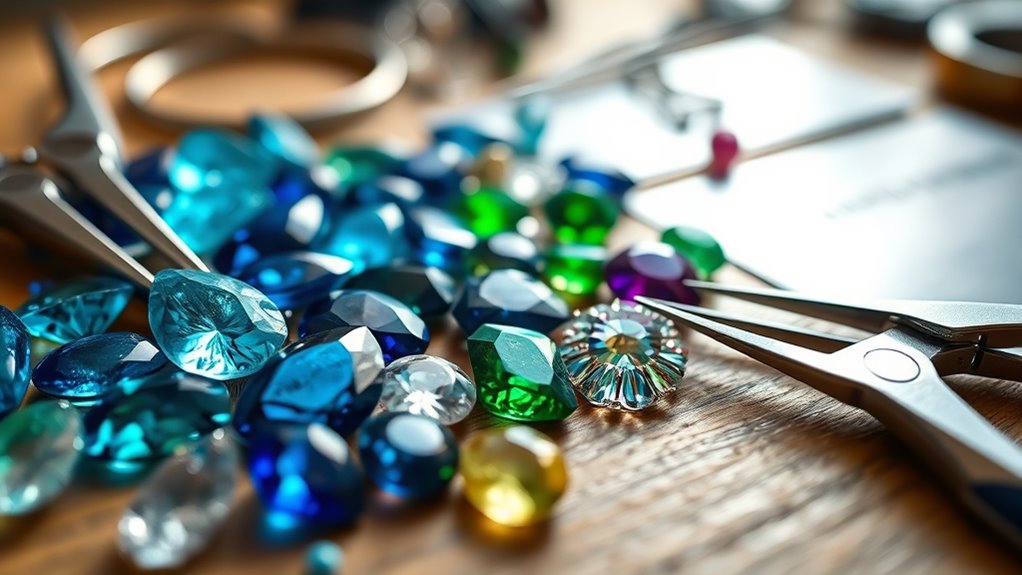
Choosing quality materials is the foundation of creating stunning handmade jewelry. When you start with high-quality components, your finished piece will look more professional and last longer. Invest in genuine gemstones, sturdy clasps, and durable metals like sterling silver or gold-filled findings. Cheaper materials may seem tempting, but they often compromise your design’s integrity and appeal. Carefully inspect beads and stones for flaws or chips, and ensure metals are free of tarnish. Using reliable suppliers guarantees consistency and quality, which elevates your craftsmanship. Remember, your jewelry reflects your skills and passion, so don’t cut corners on materials. Quality components make your work stand out and give your customers confidence in your creations. Additionally, paying attention to material durability ensures your jewelry remains beautiful over time. Incorporating trusted suppliers can also help you source the best materials for your projects. Proper material selection significantly impacts the overall appearance and longevity of your jewelry, making it more attractive and durable. For added assurance, researching material certifications can help verify the authenticity and quality of your supplies. Ultimately, the better your materials, the more impressive your jewelry will be. A focus on material quality can further enhance the overall appearance and durability of your pieces.
Plan Your Design Carefully
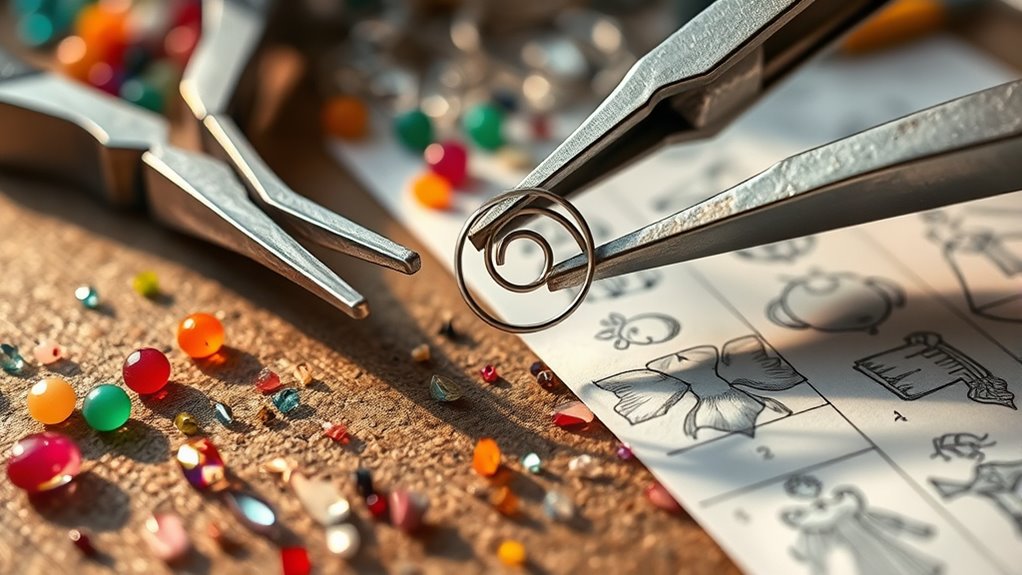
Start by sketching your ideas to visualize the overall look and details of your jewelry piece. Next, select materials that match your design and guarantee they’re suitable for your vision. Planning carefully helps you create a cohesive and stunning finished piece. Incorporating sound healing science principles can also inspire unique textures and patterns in your jewelry. Being aware of regional resources and tools can help you access high-quality supplies and expert advice to elevate your designs. For example, exploring vetted electric bike conversion kits can introduce innovative materials and technologies that inspire your craftsmanship. Additionally, understanding how technology influences artistic expression can open new creative avenues and help you stay updated with current trends in jewelry design. Paying attention to authentic natural materials can further enhance the rustic and handcrafted feel of your jewelry pieces.
Sketch Your Concepts
Before you begin crafting your jewelry, it’s vital to sketch your concepts to visualize your ideas clearly. Take a moment to draw rough outlines of your design, focusing on the overall shape, size, and placement of each element. This helps you identify potential issues early and make adjustments before working with materials. Incorporate color accuracy considerations to ensure your color choices will translate well in the final piece. Sketching also allows you to explore creative ideas quickly without wasting materials. Additionally, referencing design principles can improve the balance and harmony of your composition. Being aware of drivetrain compatibility can help you select suitable components and avoid issues during assembly. Consulting catering and delivery trends can inspire innovative presentation styles for your jewelry pieces, especially if you plan to sell or showcase your work. Recognizing beach destinations can also influence your inspiration, as the natural beauty and colors of beaches might inspire your designs. Remember, your sketches serve as a blueprint, guiding your craftsmanship and ensuring your finished piece matches your original vision.
Choose Appropriate Materials
Selecting the right materials is essential to bringing your jewelry design to life. Choose materials that match your style, budget, and the look you want to achieve. Consider durability, weight, and color to guarantee your piece not only looks stunning but also lasts. Mixing different textures and finishes can add depth to your design. Here’s a quick guide:
| Material Type | Best For |
|---|---|
| Metals | Rings, pendants, delicate chains |
| Beads | Statement pieces, accents |
| Findings | Clasps, earring hooks |
Matching your materials to your design plan ensures a cohesive and professional-looking piece. Take your time selecting each component to create jewelry that truly reflects your vision. Incorporating unique and wicked planters can inspire creative presentation ideas for handmade jewelry displays or gift packaging. Paying attention to sustainable materials not only enhances the eco-friendliness of your jewelry but also appeals to environmentally conscious customers. Additionally, understanding material compatibility helps prevent reactions or damage over time, ensuring your jewelry remains beautiful and durable. Being aware of gravel bike tire pressure can also inspire innovative ways to customize your jewelry display stands for a rugged, yet elegant presentation. Exploring dog breeds might seem unrelated, but it can also inspire themed jewelry collections based on different breeds’ characteristics and colors.
Master Basic Techniques First
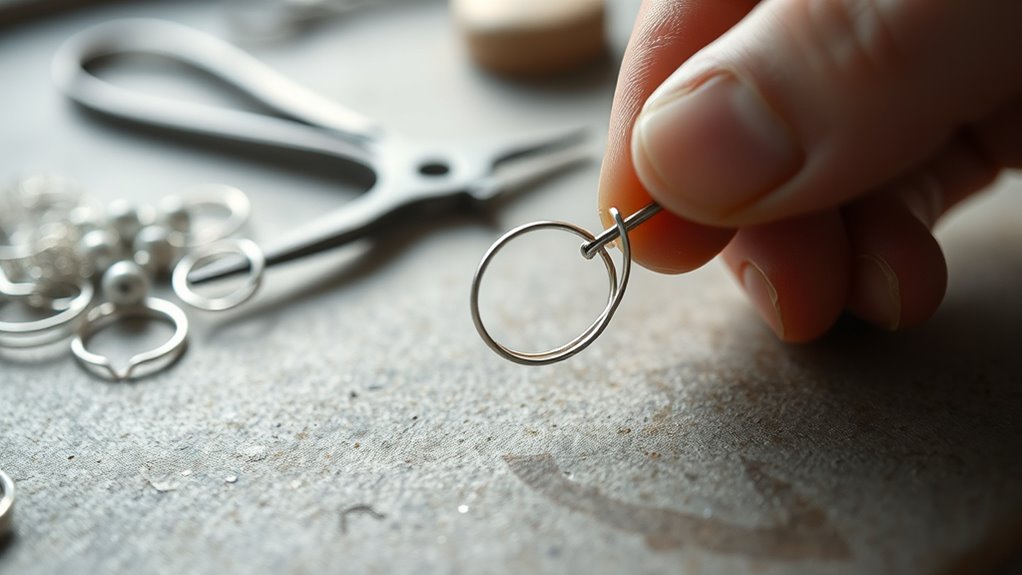
Before creating intricate designs, you should focus on mastering essential knotting skills and practicing wire wrapping techniques. Developing a good understanding of handmade jewelry techniques helps ensure your pieces are both beautiful and durable. These foundational skills allow you to build confidence and guarantee your jewelry pieces are durable. Additionally, familiarizing yourself with retirement planning strategies can help you allocate resources effectively for your craft and personal goals. Understanding the importance of father-daughter bond can inspire you to incorporate meaningful themes into your jewelry designs, making them more special. Taking the time to learn them now pays off in the quality of your finished work.
Learn Essential Knotting Skills
Mastering basic knotting techniques is essential for creating professional-looking handmade jewelry. When you learn how to tie secure, even knots, your pieces will look polished and durable.
Start with simple knots like the overhand, square, and sliding knots, which form the foundation for more complex designs. Practice these until they become second nature.
Visualize your work with:
- Smooth, tight knots that don’t slip
- Even spacing between beads and knots
- Neatly finished ends, hiding excess thread
- Consistent tension for a uniform look
- Elegant loops for clasps or charms
Focusing on these fundamentals helps you craft jewelry that’s both beautiful and long-lasting.
With solid knotting skills, you’ll confidently create intricate designs and ensure your jewelry holds together perfectly.
Practice Wire Wrapping Techniques
To create secure and polished wire-wrapped jewelry, it’s important to practice fundamental techniques thoroughly. Begin by mastering simple wraps and loops, ensuring your wire stays tight and neat. Use round-nose pliers to make smooth, consistent loops, and practice wrapping wire around stones or beads without applying excessive pressure.
Focus on controlling your tension; too tight can damage your piece, too loose can look sloppy. As you improve, experiment with different angles and techniques, like weaving or creating spirals. Repetition is key—practice until your movements feel natural and your wraps are uniform.
With patience, you’ll develop the skill to craft intricate designs confidently, resulting in professional-looking jewelry that lasts.
Pay Attention to Details and Finishing
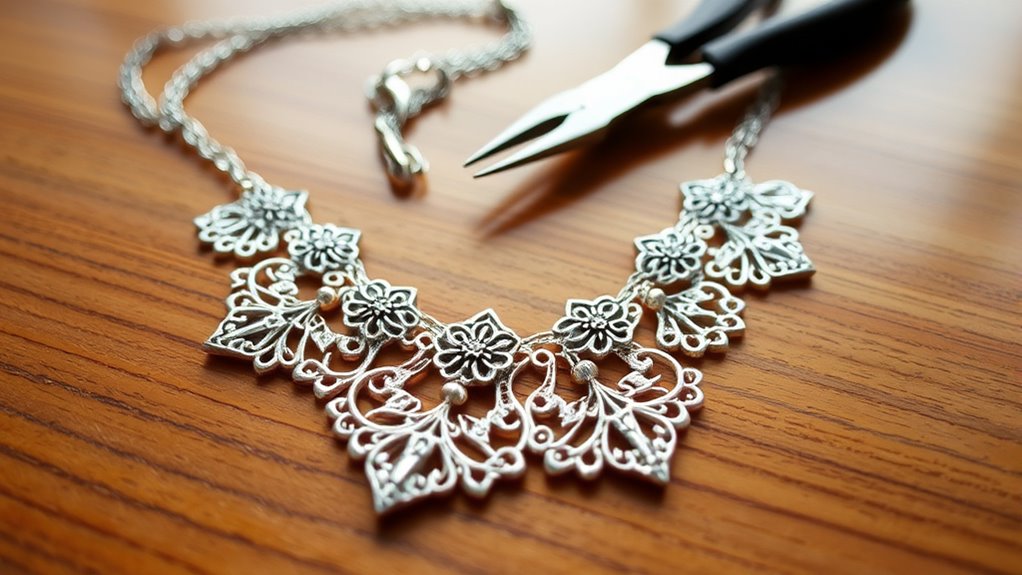
Paying close attention to details and finishing touches can make all the difference in handcrafted jewelry. Small adjustments can elevate your piece from good to stunning. Focus on smoothing rough edges, ensuring all components are securely attached, and checking for symmetry.
Polishing surfaces highlights shine and removes fingerprints or smudges. Consider adding a final touch, like a tiny bead or charm, to enhance visual interest.
Here’s what to keep in mind:
- Carefully file and smooth every edge
- Secure clasps and connectors tightly
- Polish metal surfaces to a high shine
- Double-check symmetry and alignment
- Add subtle accents for a polished look
These finishing details show your craftsmanship and commitment to quality, leaving a lasting impression on anyone who sees or wears your jewelry.
Use Tools Wisely and Safely

Using your tools wisely and safely is essential to creating beautiful handmade jewelry and avoiding accidents. Always handle sharp tools, like scissors and pliers, with care to prevent cuts. Keep your workspace organized so you can find tools quickly and avoid mishaps. Use the right tool for each task—don’t force a tool into a job it’s not designed for. Wear safety glasses when cutting or soldering to protect your eyes.
Store your tools properly after use to prevent damage and accidents. Keep blades sharp; dull tools require more force and are more likely to slip. Respect your tools and don’t rush; patience ensures precision and safety. By practicing safe habits, you’ll craft stunning jewelry without unnecessary risks.
Incorporate Personal Touches
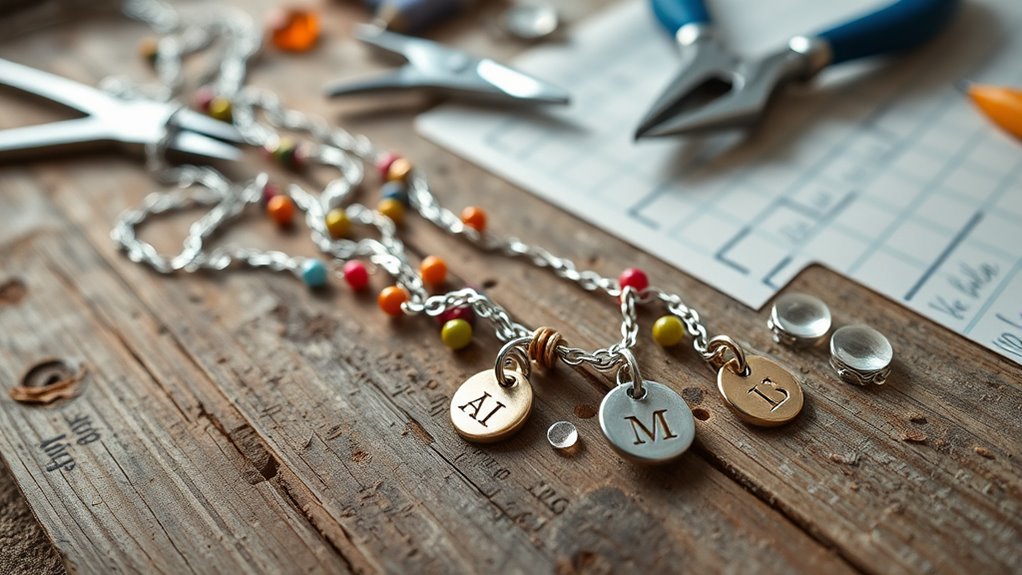
Incorporating personal touches into your jewelry makes each piece uniquely yours and reflects your individual style. Think about adding meaningful charms, engraved initials, or birthstones that tell a personal story. You can also incorporate favorite colors or textures that resonate with you.
Custom clasps or unique wire wrapping techniques add a distinctive flair. Consider embedding sentimental items, like a tiny keepsake or a special charm that symbolizes a memory. These elements transform a simple design into something deeply personal and special.
- Hand-stamped messages or initials
- Charms that represent important milestones
- Unique beads in your favorite colors
- Incorporating family heirlooms or keepsakes
- Customizable pendants with meaningful symbols
Practice Regularly and Experiment
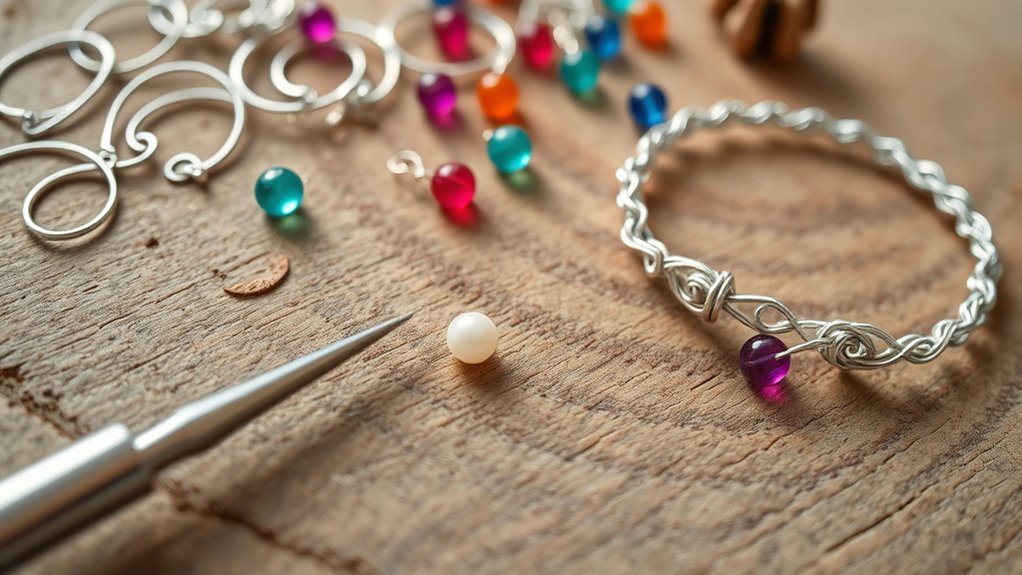
Practicing regularly is key to mastering the skills needed for creating stunning handmade jewelry. The more you work on your craft, the better you’ll understand your tools, materials, and techniques.
Set aside dedicated time each week to practice different designs, experiment with new styles, and refine your skills. Don’t be afraid to try new ideas or materials—this is how you discover your unique style.
Keep a journal or record your progress, noting what works and what doesn’t. Experimentation keeps your creativity alive and prevents your work from becoming repetitive.
Over time, you’ll develop confidence and a sharper eye for detail. Remember, every mistake is a learning opportunity that pushes your craft to the next level.
Frequently Asked Questions
How Do I Choose the Best Type of Jewelry Findings?
Choosing the best jewelry findings depends on your project’s style and function. Consider the metal type to match your beads and design, whether it’s sterling silver or gold-plated.
Think about the findings’ durability and ease of use—like jump rings for flexibility or lobster clasps for security.
Always select quality findings that complement your design, ensuring your jewelry looks professional and lasts longer. Your choice sets the foundation for stunning, durable pieces.
What Are Common Mistakes to Avoid During Assembly?
Imagine your jewelry as a story, each piece a chapter. During assembly, avoid rushing — it’s like skipping pages in a book.
Don’t forget to double-check your connections; loose findings are like torn pages.
Be cautious with glue and adhesives, which can cloud the story’s clarity.
Keep your workspace tidy to prevent losing tiny elements.
How Can I Source Unique, Affordable Materials?
To source unique, affordable materials, start by exploring local craft fairs and flea markets where you can find one-of-a-kind beads and findings.
Join online craft communities and forums to discover recommended suppliers offering quality materials at lower prices.
Don’t forget to check out wholesale suppliers and bulk purchase options online, which often provide discounts.
Be creative—recycle or repurpose materials for a truly distinctive touch in your jewelry.
What Safety Precautions Should I Follow When Using Adhesives?
Imagine you’re in the midst of your jewelry masterpiece, like a modern-day alchemist. When using adhesives, always work in a well-ventilated area to avoid inhaling fumes.
Wear gloves to protect your skin, and keep adhesives away from your eyes and children.
Read and follow manufacturer instructions carefully, and never rush the drying process.
Safety first guarantees your creative process stays fun and injury-free, just like a well-planned adventure.
How Do I Balance Creativity With Durability in Design?
Balancing creativity with durability starts by planning your design carefully. You should choose quality materials that support your artistic vision while ensuring strength, like using strong wire or sturdy clasps.
Experiment with different combinations to see what looks good and holds up well. Don’t rush the assembly process—test your jewelry for durability.
Conclusion
Believe it or not, your handmade jewelry can truly become timeless art. By choosing quality materials, honing your skills, and adding personal touches, you create pieces full of heart. Regular practice not only sharpens your craft but also connects you to a centuries-old tradition of craftsmanship—proof that dedication transforms simple materials into stunning treasures. Keep experimenting and trusting your intuition; your unique creations could inspire others just as jewelry has inspired generations.





